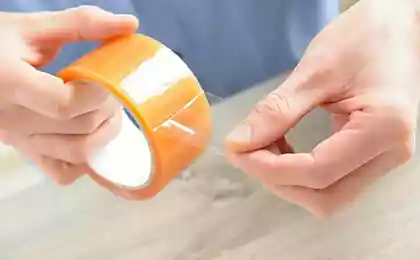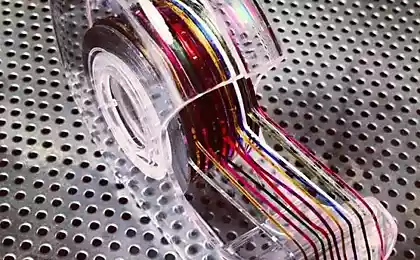712
The history of Scotch.

Everyone knows that: ... The world keeps on elephants, elephants on a turtle, a turtle on an adhesive tape ...
And who invented and where do come from Scotch?
The main condition for work in economically difficult period becomes survival. And many companies have learned to use this time to your advantage. For example - 3M Corporation, which, even during the Great Depression in the United States has learned to thrive.
30s in the United States marked the beginning of the Great American Depression. An experienced analyst would say that there is no worse time to bring a new product to market. Due to lack of money people save, do not buy anything extra, try longer use the existing things in the house.
And it helps to save tape. The invention of technical laboratory of Richard Drew, originally intended for the paint work, suddenly finds wide application in the consumer market. Even the name of the product and the trade mark under which it launches 3M were to match the surrounding atmosphere stewardship - Scotch (Scotch translated to English means "Scottish", the other meaning of the word - "miser»).
Let's start with the fact that scotch was invented by a Scotsman or tartan, and even this does not happen in Scotland. Adhesive tape was invented in America, and that's how it was.

In 1923 a young man named Richard Drew (Richard G. Drew), a banjo player (this is why something needs to be specified), he got a job in a company engaged in the production of modest sandpaper. The company Minnesota Mining and Manufacturing (Now the name of this major corporation decreased to 3M) it was prepared for the post of laboratory technician. Actually, with the sandpaper and it had to work. However, the research division of 3M was trying to learn new activities and develop waterproof coating, experimenting with cellophane. Banjo player, these wrappers have been interesting, but at the moment his employer tested the shops and garages his new skins «Wetordry», and Drew was entrusted to oversee this process. Once, while in the body shop, Richard noticed that the master engaged in painting car bodies, have difficulty: where the surface had to paint two or more colors, the dividing line is that sloppy. Although protection of one dyed plane and used paper entitled Kraft Paper, by removing these papers are separated together with the ink. In general - it was uncomfortable. And Drew has promised painter to think of something.

Some time later - in 1925 - Richard really brought this to the employee the tape width of 2 inches (5 cm) with a plaster on each edge. "Avtozhivopisets" decided to use the prototype in the case, but when going to apply another color, notice that the tape Drew skukozhilas. Only then can the master tape carefully studied and realized that she had just glued on the edges and in the middle - not (now say that Richard did not totally sticky sample for reasons of cost). And as in the days of the Scottish thrift - or rather, avarice, legends, the disgruntled painter in the hearts cried out, "Take this tape, send your Scotch bosses and tell them to make it more sticky!" It is clear that no «Scotch bosses» Drew was not, but a word to the tape seemed stuck, and the inventor of the experiments continued. To this end, in June 1929 ordered a banjo player of 90 meters of cellophane. In the process of improving Richard had to solve many problems, such as uniform distribution of mass on the surface of the adhesive tape, and so on. On completion it took about 5 years, and September 8, 1930 the first roll of "Scotch" cellophane tape was sent to a sample of clients in Chicago. The answer came to him reassuring: "You can be sure not to save money by releasing it to the market. Sales volume will justify all costs ».
The world's first tape was made of rubber, resins and oils on the basis of cellophane. He was waterproof and withstand a wide range of temperatures. However, initially intended to scotch sealing wrapper for food. She had to use the bakers, grocers and meat packers. But people who are forced to save during the Great Depression, have thought up hundreds of new ways to use an adhesive tape at work and home: from sealing packages of clothing to the store broken eggs. This is where the scotch tape and met with torn pages of books and papers, broken toys, not sealed windows in winter, and even dilapidated bills.

With tape Scotch hostess sealed packages of milk to make it last longer is not sour, mending toys and books, farmers are sealed with a cracked turkey egg, and, in addition, we give a fitting rebuff voracious rodents they primatyvali flashlight to the barrel, which allowed them to see intruders in the dark and to protect crops from nocturnal forays.

To without breaking watermelon, sweet to know whether he had invented an original way: cut the center and see the flesh. If the flesh is not quite ripe, a piece back in place, sealed with tape and left to ripen.

The tape began to use everywhere - sometimes even in the most ordinary purposes. For example, stuck on the hole cans with soda piece of tape. This created a certain sound effect, and all the insects ran on a picnic.

Tape sealed with tiny holes in the glass, and it can help prolong the life of the polished table: on the bottom glasses and ashtrays stuck duct tape, and it has been finished with scratches.
By the beginning of World War II, duct tape has become so indispensable in the household, even the company 3M has launched a commercial on television apologizing for the lack of housewives Scotch adhesive tape in stores.
The company's plants fulfill state orders. "As soon as we win, - said the announcer in a commercial - duct tape will return to your homes and offices!" Indispensability tape confirmed that was released a music promotional video with a special song about the tape Scotch, helping to create a hairstyle.
In 1932, 3M sales manager John Borden (John A. Borden) came up with a roll of Scotch tape to complement "built-in" blade, which greatly facilitated the use of tape. Some other improvements and expansion of the range occurred in 1945, 1961, 1995 and 1997.
Today the family of 3M Scotch more than 900 names. How successfully has developed the life of the inventor, Richard Drew, is hard to say. Not that he is fabulously rich, or that died in poverty, are not reported. Even with years of life a mess. According to some sources, he lived from 1886 to 1982, that is - almost a hundred years old, the other 96. - from 1899 to 1980, then - in '81.
That's where something like our world collapsed sticky thingy ...























